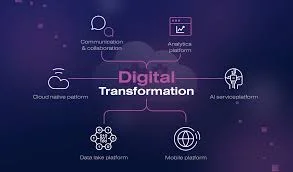 The global COVID-19 pandemic has significantly accelerated digital transformation, forcing businesses and institutions to adapt rapidly to a new reality dominated by remote work, digital services, and online communication. From healthcare to education, industries worldwide have shifted their operations online in response to the pandemic, with the adoption of digital tools and technologies reaching unprecedented levels.
The global COVID-19 pandemic has significantly accelerated digital transformation, forcing businesses and institutions to adapt rapidly to a new reality dominated by remote work, digital services, and online communication. From healthcare to education, industries worldwide have shifted their operations online in response to the pandemic, with the adoption of digital tools and technologies reaching unprecedented levels.
Remote Work and Collaboration Tools
One of the most significant impacts of COVID-19 on digital transformation has been the rapid adoption of remote work solutions. In early 2020, millions of employees worldwide transitioned to working from home as lockdowns and social distancing measures were implemented. According to a report by McKinsey, the pandemic fast-tracked the adoption of digital collaboration tools like Zoom, Microsoft Teams, and Slack, with these platforms seeing record growth during the pandemic’s peak.
A Gartner survey revealed that 88% of organizations encouraged or mandated remote work during the pandemic, a trend that is expected to continue even in a post-pandemic world. This shift has forced companies to invest in digital infrastructure and cybersecurity to support long-term remote work.
Healthcare and Telemedicine
Healthcare is another sector where digital transformation has accelerated dramatically due to the pandemic. The need to minimize in-person interactions led to a surge in telemedicine, with healthcare providers adopting virtual consultations to manage patient care. The World Health Organization (WHO) reported that telemedicine usage increased by more than 50% in 2020, and many countries expanded their digital healthcare infrastructure to meet the demand.
In Africa and parts of Asia, tech startups and governments collaborated to build digital platforms that allowed patients to access healthcare remotely. These platforms leveraged artificial intelligence and data analytics to enhance patient diagnosis and treatment, signaling a shift toward a more technology-driven healthcare system.
Education and E-Learning
COVID-19 also forced the education sector to undergo rapid digital transformation. Schools and universities worldwide closed their physical campuses and shifted to online learning models. A UNESCO report found that by April 2020, over 1.5 billion students across 190 countries were affected by school closures, with institutions turning to e-learning platforms like Google Classroom, Zoom, and Microsoft Teams to continue instruction.
This accelerated adoption of digital education tools has reshaped the future of learning, with many institutions now offering hybrid models that blend in-person and online classes. However, challenges such as digital inequality, especially in developing countries, remain a significant barrier to widespread adoption.
Retail and E-Commerce
The retail sector also experienced a surge in digital transformation, with e-commerce becoming the primary channel for businesses during the pandemic. Lockdowns and social distancing measures led to a sharp increase in online shopping, with platforms like Amazon, Alibaba, and Jumia seeing record sales volumes. According to a report by eMarketer, global e-commerce sales grew by 27.6% in 2020, with digital payments and contactless delivery systems gaining traction as consumer preferences shifted.
Retailers worldwide invested in digital platforms, mobile apps, and AI-driven customer service solutions to meet the demand for online services, accelerating the digitalization of the retail industry.






















